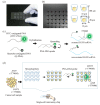Analysis of Single Nucleotide-Mutated Single-Cancer Cells Using the Combined Technologies of Single-Cell Microarray Chips and Peptide Nucleic Acid-DNA Probes
- PMID: 32605095
- PMCID: PMC7407912
- DOI: 10.3390/mi11070628
Analysis of Single Nucleotide-Mutated Single-Cancer Cells Using the Combined Technologies of Single-Cell Microarray Chips and Peptide Nucleic Acid-DNA Probes
Abstract
Research into cancer cells that harbor gene mutations relating to anticancer drug-resistance at the single-cell level has focused on the diagnosis of, or treatment for, cancer. Several methods have been reported for detecting gene-mutated cells within a large number of non-mutated cells; however, target single nucleotide-mutated cells within a large number of cell samples, such as cancer tissue, are still difficult to analyze. In this study, a new system is developed to detect and isolate single-cancer cells expressing the T790M-mutated epidermal growth factor receptor (EGFR) mRNA from multiple non-mutated cancer cells by combining single-cell microarray chips and peptide nucleic acid (PNA)-DNA probes. The single-cell microarray chip is made of polystyrene with 62,410 microchambers (31-40 µm diameter). The T790M-mutated lung cancer cell line, NCI-H1975, and non-mutated lung cancer cell line, A549, were successfully separated into single cells in each microchambers on the chip. Only NCI-H1975 cell was stained on the chip with a fluorescein isothiocyanate (FITC)-conjugated PNA probe for specifically detecting T790M mutation. Of the NCI-H1975 cells that spiked into A549 cells, 0-20% were quantitatively analyzed within 1 h, depending on the spike concentration. Therefore, our system could be useful in analyzing cancer tissue that contains a few anticancer drug-resistant cells.
Keywords: T790M mutation; cell microarray; epidermal growth factor receptor (EGFR); lung cancer; peptide nucleic acid (PNA) probe; single nucleotide mutation; single-cell analysis.
Conflict of interest statement
The authors declare no competing financial interests.
Figures



Similar articles
-
Imaging analysis of EGFR mutated cancer cells using peptide nucleic acid (PNA)-DNA probes.Analyst. 2019 Aug 7;144(15):4613-4621. doi: 10.1039/c9an00725c. Epub 2019 Jun 26. Analyst. 2019. PMID: 31241068
-
Predicting outcomes of EGFR-targeted therapy in non-small cell lung cancer patients using pleural effusions samples and peptide nucleic acid probe assay.Clin Chem Lab Med. 2017 Oct 26;55(12):1979-1986. doi: 10.1515/cclm-2016-0809. Clin Chem Lab Med. 2017. PMID: 28787267
-
Impact of bevacizumab in combination with erlotinib on EGFR-mutated non-small cell lung cancer xenograft models with T790M mutation or MET amplification.Int J Cancer. 2016 Feb 15;138(4):1024-32. doi: 10.1002/ijc.29848. Epub 2015 Oct 13. Int J Cancer. 2016. PMID: 26370161
-
Arsenic circumvents the gefitinib resistance by binding to P62 and mediating autophagic degradation of EGFR in non-small cell lung cancer.Cell Death Dis. 2018 Sep 20;9(10):963. doi: 10.1038/s41419-018-0998-7. Cell Death Dis. 2018. PMID: 30237564 Free PMC article.
-
Effect of siRNAs targeting the EGFR T790M mutation in a non-small cell lung cancer cell line resistant to EGFR tyrosine kinase inhibitors and combination with various agents.Biochem Biophys Res Commun. 2013 Feb 15;431(3):623-9. doi: 10.1016/j.bbrc.2012.12.070. Epub 2012 Dec 22. Biochem Biophys Res Commun. 2013. PMID: 23266614
Cited by
-
Single-Cell Microarray Chip with Inverse-Tapered Wells to Maintain High Ratio of Cell Trapping.Micromachines (Basel). 2023 Feb 20;14(2):492. doi: 10.3390/mi14020492. Micromachines (Basel). 2023. PMID: 36838192 Free PMC article.
-
Localization of EGFR Mutations in Non-small-cell Lung Cancer Tissues Using Mutation-specific PNA-DNA Probes.Cancer Genomics Proteomics. 2023 Jul-Aug;20(4):375-382. doi: 10.21873/cgp.20389. Cancer Genomics Proteomics. 2023. PMID: 37400147 Free PMC article.
-
Editorial for the Special Issue on Micro and Nano Devices for Cell Analysis.Micromachines (Basel). 2021 Jul 19;12(7):840. doi: 10.3390/mi12070840. Micromachines (Basel). 2021. PMID: 34357250 Free PMC article.
-
Novel Quick Cell Patterning Using Light-Responsive Gas-Generating Polymer and Fluorescence Microscope.Micromachines (Basel). 2022 Feb 18;13(2):320. doi: 10.3390/mi13020320. Micromachines (Basel). 2022. PMID: 35208444 Free PMC article.
-
Progress and application of lung-on-a-chip for lung cancer.Front Bioeng Biotechnol. 2024 May 24;12:1378299. doi: 10.3389/fbioe.2024.1378299. eCollection 2024. Front Bioeng Biotechnol. 2024. PMID: 38854856 Free PMC article. Review.
References
-
- Shigeto H., Yamamura S. Bioluminescence resonance energy transfer (BRET)-based biosensing probes using novel luminescent and fluorescent protein pairs. Sens. Mater. 2019;31:71–78. doi: 10.18494/SAM.2019.2049. - DOI
Grants and funding
LinkOut - more resources
Full Text Sources
Research Materials
Miscellaneous

